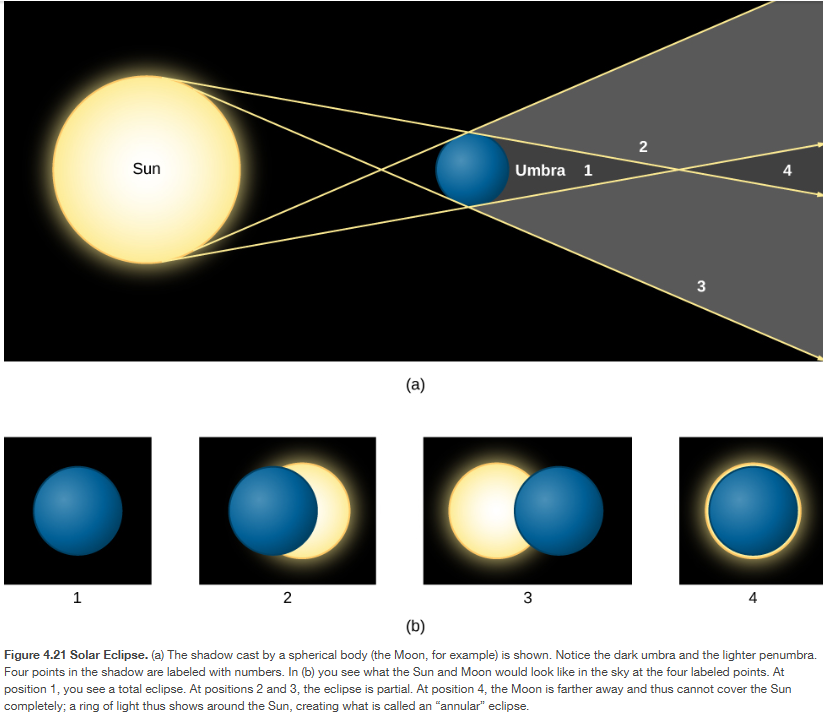chapter 4.7; eclipses of the Sun and Moon
1/11
There's no tags or description
Looks like no tags are added yet.
Name | Mastery | Learn | Test | Matching | Spaced |
|---|
No study sessions yet.
12 Terms
Sun vs Moon
Sun and Moon appear to be the same size from Earth
Sun is 400 times larger in diameter than the Moon
Sun is 400 times farther away
so, both the Sun and Moon have the same angular size (about ½ degree)
eclipse
occurs whenever any part of either Earth or the Moon enters the shadow of the other
solar eclipse
when the Moon’s shadow strikes Earth, people within that shadow see the Sun at least partially covered by the Moon
lunar eclipse
when the Moon passes into the shadow of Earth, people on the night side of Earth see the Moon darken
shadows of Earth and the Moon
2 parts:
umbra: a cone where the shadow is darkest
penumbra: lighter, more diffuse region of darkness


eclipse season
when the two paths of the Moon and Sun cross
eclipses are possible during this point
annular eclipse
an eclipse of the sun in which the edge of the sun remains visible as a bright ring around the moon
total solar eclipse
if an eclipse of the Sun occurs when the Moon is somewhat nearer than its average distance, the Moon can completely hide the Sun
occurs at those times when the umbra of the moon’s shadow reaches the surface of Earth
if the Sun and Moon are properly aligned, then the Moon’s darkest shadow intersects the group at a small point on Earth’s surface, anyone on Earth within the small area covered by the tip of the Moon’s shadow will, for a few minutes, be unable to see the Sun and will witness a total eclipse
at the same time, observers on a larger area of earth’s surface who are in the penumbra will se only a part of the Sun eclipsed by the Moon (partial solar eclipse)
duration will never exceed approx. 7 minutes
tip of the Moon’s shadow sweeps eastward at about 1500km/h
eclipse path
the thin zone across Earth within which a total solar eclipse is visible
within a region about 3000km on either side of the eclipse path, a partial eclipse is visible
appearance of a total eclipse
A solar eclipse starts when the Moon just begins to silhouette itself against the edge of the Sun’s disk
A partial phase follows, during which more and more of the Sun is covered by the Moon
About an hour after the eclipse begins, the Sun becomes completely hidden behind the Moon
In the few minutes immediately before this period of totality begins, the sky noticeably darkens, some flowers close up, and chickens may go to roost
As an eerie twilight suddenly descends during the day, other animals (and people) may get disoriented
During totality, the sky is dark enough that planets become visible in the sky, and usually the brighter stars do as well
Gradually, the partial phases of the eclipse repeat themselves, in reverse order, until the Moon has completely uncovered the Sun
corona
the Sun’s outer atmosphere, consisting of sparse gases that extend for millions of miles in all directions from the apparent surface of the Sun
It is ordinarily not visible because the light of the corona is feeble compared with the light from the underlying layers of the Sun
Only when the brilliant glare from the Sun’s visible disk is blotted out by the Moon during a total eclipse is the pearly white corona visible
lunar eclipse
occurs when the Moon enters the shadow of Earth
Earth’s shadow: 1.4 million km long
visible to everyone who can see the Moon
An eclipse of the Moon is total only if the Moon’s path carries it though Earth’s umbra
can take place ONLY when the Sun, Earth, and Moon are in a line
The total duration of the eclipse depends on how closely the Moon’s path approaches the axis of the shadow
occur every 2-3 years